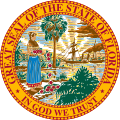LeRoy Collins
Thomas LeRoy Collins (March 10, 1909 - March 12, 1991) was the thirty-third governor of Florida.
Early life
LeRoy Collins was born and raised in Tallahassee, Florida, where he attended Leon High School. He went on to attend the Eastman School of Business in New York and then went on to the Cumberland Law School in Birmingham, Alabama to receive a law degree. In 1932, he married Mary Call Darby, great-granddaughter of Richard K. Call, twice Territorial Governor of Florida.
Politics
His entry into public service began in 1934, when he was elected as Leon County's representative to the Florida House. He continued to serve in the House until 1940, when he was elected to the Florida Senate to fill an unexpired term. In 1941, he purchased the home built by Richard K. Call in Tallahassee, "The Grove", which is located across the street north of the official Governor's Mansion in Tallahassee. He was re-elected in 1942, but resigned to fight in the U.S. Navy during World War II. After the war, he was elected once again to the Florida Senate in 1946. He was reelected in 1950, serving until 1954 when a special election was held to fill the remaining two years of Governor Daniel T. McCarty, who had died in office in 1953.
Governorship
He won the special election in 1954 and was sworn in as governor on January 4, 1955. In 1956, he was reelected to serve a regular four-year term. In the 1956 election, he made history by becoming the first governor to win election in the first primary election, defeating five other candidates. During his term, Collins focused on education, working to strengthen the state's school system. In the racial unrest of his time he took a moderate course, counselling progress under law, and the state experienced only minimal disorder.
Post-governorship
Upon completion of six years as governor, he became president of the National Association of Broadcasters. He resigned this at the request of President Lyndon B. Johnson to become the first Director of the Community Relations Service under the 1964 Civil Rights Act. Also by Presidential appointment, he became Under Secretary of Commerce on July 7, 1965. He resigned this position effective October 1, 1966 to return to Florida and become a partner in a Tampa law firm. He was successful in obtaining the Democratic nomination for the U.S. Senate in the primary elections of 1968 but was defeated in the general election. After his defeat, he left his law firm in Tampa and returned to "The Grove" in Tallahassee until his death from cancer in 1991. He was called many times by Florida governors Ruben Askew and Bob Graham the greatest Governor that Florida ever had. A tribute was entered in the official record of the United States House of Representatives on March 19, 1991 by Florida Representatives James Bacchus and Charles E. Bennett.
External links
Official Governor's portrait and biography from the State of Florida

